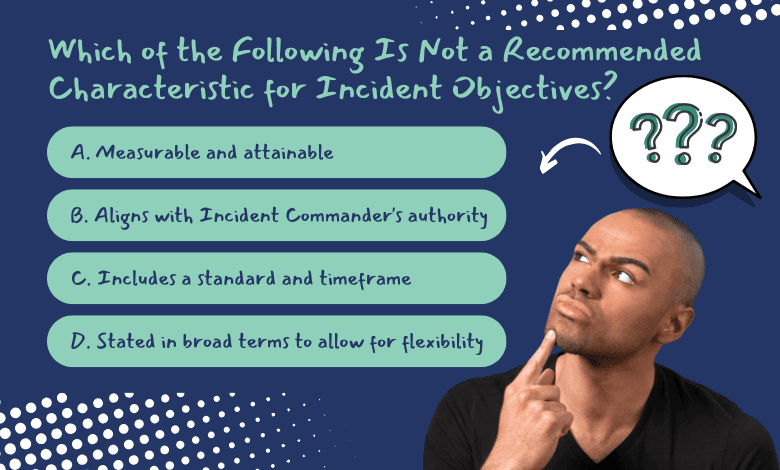Which of the Following Is Not a Recommended Characteristic for Incident Objectives?

When managing an incident, whether it’s an emergency response, a cybersecurity breach, or a natural disaster, having clear and effective incident objectives is crucial. These objectives guide decision-making, resource allocation, and overall response efforts. However, not all characteristics of incident objectives are equally beneficial—some may hinder rather than help the response process.
The question asks: “Which of the following is not a recommended characteristic for incident objectives?” with the following options:
- A. Measurable and attainable
- B. In accordance with the Incident Commander’s authorities
- C. Includes a standard and timeframe
- D. Stated in broad terms to allow for flexibility
To determine the correct answer, we must analyze each option in the context of effective incident management principles.
Understanding Effective Incident Objectives
Incident objectives serve as the foundation for an organized response. According to best practices in emergency management (such as those outlined by the Federal Emergency Management Agency (FEMA) and the Incident Command System (ICS), effective incident objectives should:
- Be Specific – Clearly defined to avoid ambiguity.
- Be Measurable – Progress should be trackable.
- Be Attainable – Realistic given available resources.
- Include a Timeframe – Deadlines ensure accountability.
- Align with Authorities – Must comply with legal and organizational guidelines.
With these principles in mind, let’s evaluate each option.
Analysis of Each Option
Option A: Measurable and Attainable
Measurable objectives allow responders to track progress and determine whether the response is on track. Attainability ensures that goals are realistic given the resources and constraints.
- Example: “Reduce the active fire perimeter by 30% within the next 12 hours using available ground crews and aerial support.“
- Why It’s Recommended?
- Enables performance evaluation.
- Prevents setting unrealistic expectations.
Conclusion: This is a recommended characteristic.
Option B: In Accordance with the Incident Commander’s Authorities
Incident objectives must operate within the legal and organizational boundaries of the Incident Commander’s role. Overstepping authority can lead to legal issues or ineffective resource deployment.
- Example: A local fire chief cannot unilaterally mandate federal resources without proper protocols.
- Why It’s Recommended?
- Ensures compliance with jurisdictional policies.
- Prevents overreach and confusion in chain of command.
Conclusion: This is a recommended characteristic.
Option C: Includes a Standard and Timeframe
A well-structured incident objective should specify what success looks like (the standard) and by when it should be achieved (timeframe).
- Example: “Restore power to 95% of affected households within 48 hours.“
- Why It’s Recommended?
- Provides clear benchmarks for success.
- Helps prioritize tasks and allocate resources efficiently.
Conclusion: This is a recommended characteristic.
Option D: Stated in Broad Terms to Allow for Flexibility
While flexibility is important in dynamic incidents, objectives that are too broad can lead to confusion, misalignment, and inefficiency.
- Example: “Improve the situation as much as possible.” (Too vague)
- Why It’s NOT Recommended?
- Lacks specificity, making it hard to measure progress.
- Can result in conflicting interpretations among teams.
- Hinders accountability since success is not clearly defined.
Conclusion: This is not a recommended characteristic.
Final Answer: D is the Correct Choice
The characteristic that is not recommended for incident objectives is:
D. Stated in broad terms to allow for flexibility
While adaptability is important in incident management, objectives must remain specific, measurable, and time-bound to ensure an effective response. Broadly stated objectives create ambiguity, which can delay decision-making and reduce operational efficiency.
Why the Other Options Are Strong Characteristics
- Measurable and attainable (A) ensures goals are realistic and progress can be assessed.
- Alignment with authorities (B) maintains legal and operational integrity.
- Standards and timeframes (C) provide structure and urgency.
Best Practices for Developing Incident Objectives
To ensure incident objectives are effective, follow these guidelines:
- Use the SMART Criteria – Specific, Measurable, Achievable, Relevant, Time-bound.
- Align with Priorities – Life safety, incident stabilization, and property/environmental protection should guide objectives.
- Communicate Clearly – All response teams should understand the objectives without ambiguity.
- Review and Adapt – While initial objectives should be specific, they can be adjusted based on changing conditions—but never at the cost of clarity.
Conclusion
Effective incident management relies on well-defined objectives that drive coordinated action. While flexibility is necessary in dynamic situations, objectives must not be so broad that they lose their directive power. The correct answer to the question is D, as incident objectives should avoid vague language in favor of precision, measurability, and structured timelines.
By adhering to these principles, incident commanders can ensure a more efficient, accountable, and successful response to emergencies.



